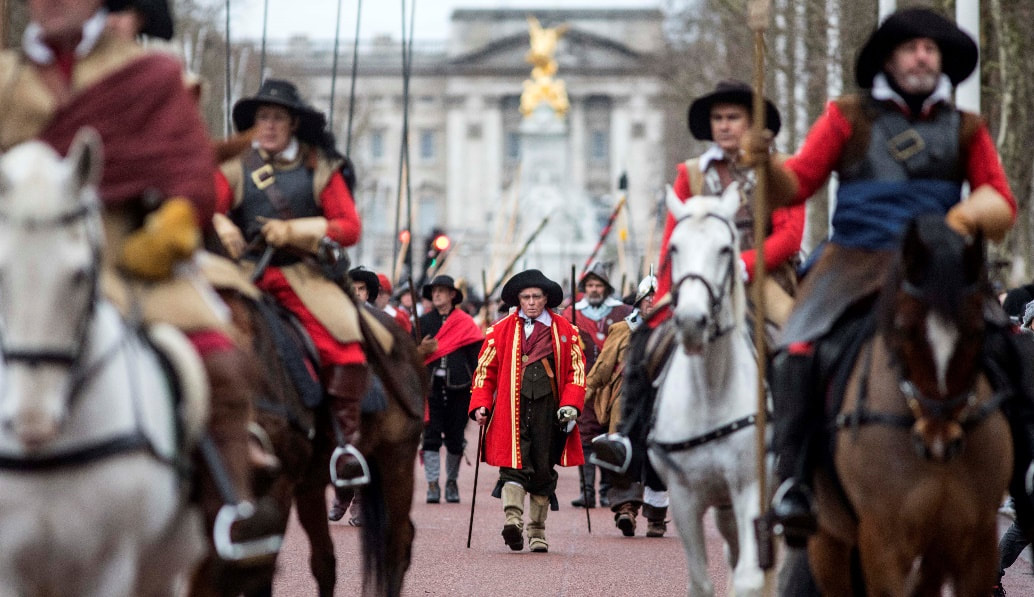‘The Charles I Commemoration Parade’ - Today
Nowadays, on the last Sunday in every January, The King’s Army of the English Civil War Society assembles in full funeral dress on the Mall by St James’s Palace.
His Majestie’s Horse troop his Colour which the Army salutes.
Then with great solemnity and with the soldiers carrying their arms in funeral order, a wreath, which ‘Remembers’ His Majestie’s horrid murder, is escorted along the Mall onto Horse Guards where the whole Army is formed up.
A religious drumhead service is held, a Colour is trooped and blessed, the Oath of Loyalty is administered and commissions and awards are presented.
At this point the wreath is trooped around the whole army before being taken by the honour guard through Horse Guards Arch and across to the Banqueting House and laid where the Horrid and Bloodie deed was carried out.
Whilst this takes place the Army remove their funeral dress and resume a martial order before retracing their route back to St James’s with drums beating and Colours flying.
Here, with great shouts and acclamations to their King, they brave the rebels to come out of the city and fight them in the year ahead.
The King’s Army follow the exact route His Majestie took on that morning through St James's Park and across what is now Horse Guards, where he would have entered a gallery of Whitehall Palace now long gone that bridged over the tilt yard in Whitehall and entered the Banqueting House.
It is a great honour and privilege for us to be allowed to use this area to commemorate His Majestie’s martyrdom.
A black mark on the clock above Horse Guards at 2.00 pm remembers the time of the King’s death.
As a part of the commemoration a wreath is laid also by the Council of Warre of the King’s Army at the equestrian statute of Charles I at the top end of Whitehall in Trafalgar Square.
This bronze statue was made by Hubert Le Sueur in 1633, but was hidden during the Commonwealth.
It was re-erected in 1675 on the site of the most elaborate Eleanor Cross erected by Edward I, which was demolished by order of Parliament in 1647.
This point, Charing Cross, marks the centre of London and road distances are taken from here.
Nowadays, on the last Sunday in every January, The King’s Army of the English Civil War Society assembles in full funeral dress on the Mall by St James’s Palace.
His Majestie’s Horse troop his Colour which the Army salutes.
Then with great solemnity and with the soldiers carrying their arms in funeral order, a wreath, which ‘Remembers’ His Majestie’s horrid murder, is escorted along the Mall onto Horse Guards where the whole Army is formed up.
A religious drumhead service is held, a Colour is trooped and blessed, the Oath of Loyalty is administered and commissions and awards are presented.
At this point the wreath is trooped around the whole army before being taken by the honour guard through Horse Guards Arch and across to the Banqueting House and laid where the Horrid and Bloodie deed was carried out.
Whilst this takes place the Army remove their funeral dress and resume a martial order before retracing their route back to St James’s with drums beating and Colours flying.
Here, with great shouts and acclamations to their King, they brave the rebels to come out of the city and fight them in the year ahead.
The King’s Army follow the exact route His Majestie took on that morning through St James's Park and across what is now Horse Guards, where he would have entered a gallery of Whitehall Palace now long gone that bridged over the tilt yard in Whitehall and entered the Banqueting House.
It is a great honour and privilege for us to be allowed to use this area to commemorate His Majestie’s martyrdom.
A black mark on the clock above Horse Guards at 2.00 pm remembers the time of the King’s death.
As a part of the commemoration a wreath is laid also by the Council of Warre of the King’s Army at the equestrian statute of Charles I at the top end of Whitehall in Trafalgar Square.
This bronze statue was made by Hubert Le Sueur in 1633, but was hidden during the Commonwealth.
It was re-erected in 1675 on the site of the most elaborate Eleanor Cross erected by Edward I, which was demolished by order of Parliament in 1647.
This point, Charing Cross, marks the centre of London and road distances are taken from here.
